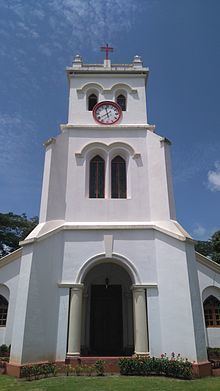Country India Tradition Anglican Completed 1843 Architectural style English Baroque | Consecrated 1843 Opened 1843 Groundbreaking 1841 | |
 | ||
Similar St Paul's Church - Bangalore, Kadri Manjunath Temple, Sultan Battery, Tannirbhavi Beach, Mangaladevi Temple | ||
St. Paul's Church is an Anglican church in Mangalore, India.
Contents
St. Paul's Church is located at the south-west corner of the Nehru Maidan (formerly the Central Maidan) in Mangalore. It was the first Protestant church to be raised in the South Kanara region. St. Paul's was originally a garrison church, raised by the British India army of the Madras Government, built using prison labour. St. Paul's is an imposing structure amidst the chaos of the fish market, service bus stand, and the State Bank of India.
History
Following the Coorg rebellion of 1837, the city of Mangalore was fortified and the British army unit based there was strengthened. This resulted in a need for the church to meet the spiritual and moral needs of the British soldiers and citizens. Hence, in 1841, Rev. R. W. Whitford, garrison chaplain appealed to the Government of Madras to construct a church in Mangalore, which was accepted. In 1842, Rev. Alfred Fennell succeeded Rev. Whitford. The church building was completed in 1842, and consecrated by George Spencer, Church of England, Bishop of Madras, on 5 January 1843.
Construction
The construction site of the St. Paul's Church, Mangalore, was at the Fort St Sebastian, the main seat of British power in Canara, on a 0.5-acre (0.2 ha) plot.
The initial budget was ₨ 5,128, and was to accommodate 120 people. However, as a result of rising costs and insufficient funds it was decided to reduce the capacity of the church building to 100. The building works were initiated in 1842 by Rev. Alfred Fennel, and the church building was completed and was furnished before the arrival of Bishop Spencer to Mangalore, and was consecrated on 5 January 1843. The final cost of construction was ₨ 7,215. The church was constructed using prison labour.
After construction, the internal area of the church is 57 by 25 feet (17.4 m × 7.6 m), with sufficient place allowed for the pulpit, sanctuary, lectern and clergy stall, could seat nearly 100 people.
Clock Tower
Extensive repairs to the church were undertaken in 1897, during which the church tower was added. The church tower of St. Paul's has a clock, with two dials. The clock was made in the Mangalore workshop of the Basel Mission, and installed by its German missionaries. The clock continues to function accurately. After the demolition of clock tower in Hampankatta, the clock tower of St. Paul's is the only remaining clock tower in Mangalore.
Basel Mission
The German missionaries of the Basel Mission worshipped in St. Paul's Church until 1862, when the Balmatta Hill Shanti Church (now Cathedral) was established.
Present Status
In 1947, after Indian Independence, St. Paul's became part of the Church of South India, under the CSI North Kerala Diocese. In 1971, it was transferred to the Karnataka Southern Diocese. It presently has around 115 families as members, and also strives to meet the spiritual needs of locals, and domestic and foreign visitors. In 2003, a community hall, located at the rear of the church, was inaugurated by Rev. C. L. Furtado, CSI Bishop of Mangalore.
St. Paul's Cemetery
St. Paul's Cemetery is located on Old Kent Road, near the railway tracks of the Mangalore Central Station, and is the resting place of many officers of the East India Company and British citizens. A notable grave is that Brigadier General John Carnac, Commander-in-Chief of forces at Bengal, who in 1761 defeated Shah Zaddar, and died in Mangalore, aged 84, on 29 November 1800. The church records the officers of the East India Company who died in battle from 1855, and burial records from 1859.
